The Beauty of Riga District
The Different Parishes
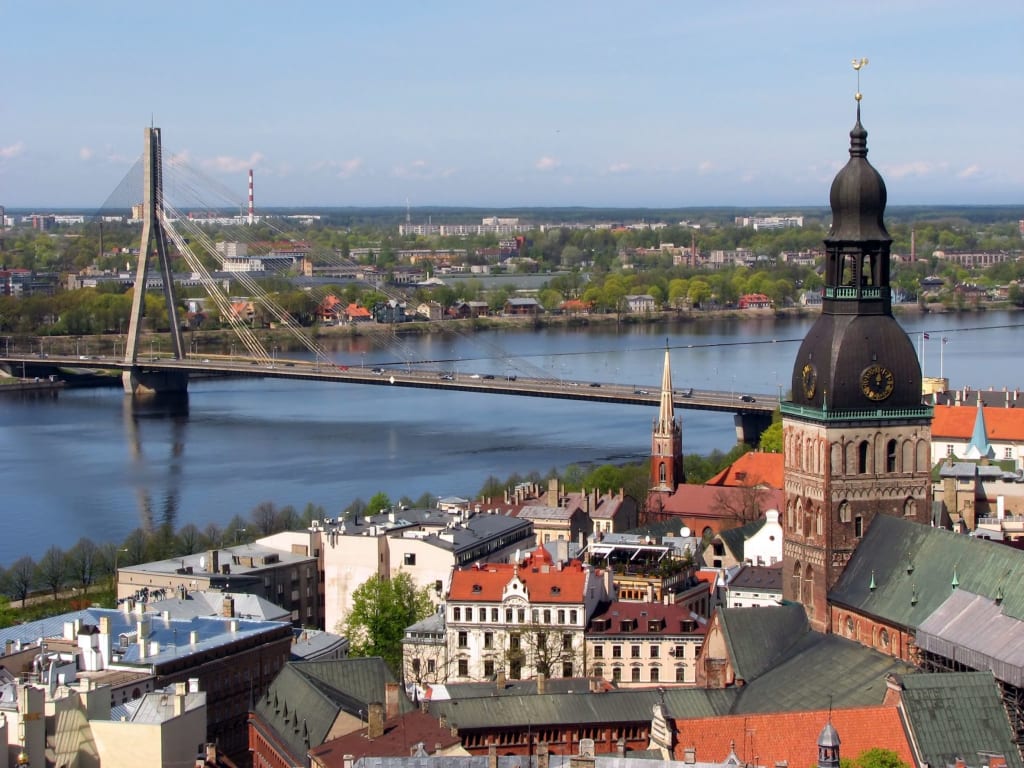
Riga, the capital of Latvia, has more to it than just city. Riga District surrounds this lovely city, which is divided into two by the Daugava. The Riga District can be considered as a suburban zone. Altogether there are 17 parishes and seven towns among which are three towns that have attached rural territories. Much of the Riga District lies on an ancient seabed. It was through the district that at one time flowed the Daugava, Gauja and Lielupe Rivers.
Adazu Parish
Baltezers Church

Adazu Parish covers quite a large land area around the lower part of the Gauja River. Most of the population lives in the village of Adazi which lies along the Riga-Ainazi Road. The village of Adazi was once a fortified castle town in the Middle Ages. Its oldest surviving structure and now an important architectural monument is the Adazi, also known as the Baltezers Church. The church is found in a lovely spot between Big White and Little White Lakes. This church was built between 1772 and 1774 by architect Bernhard Joachim and is in the Baroque style. During the Soviet occupation, the church was demolished and used for storage needs. It was returned to the Lutheran segregation in 1994.
Near Little White Lake or Mazais Baltezers is a pump station which provides drinking water for Riga. It was built in the early 20th century. Here one can find many industrial and residential buildings which were built between 1901 and 1904 in the Eclecticism style. The original pump building is now a museum. Adazi has become a well-established village with an administrative and retail center. Close by the banks of the Gauja, a modern school building was built in 1984 and here in the teaching process, they use the so-called Waldorf method. Along the shores of the Big Whitelake or Lielais Baltezers, people have built summer homes and an artist’s colony has developed on a peninsula. Adazi claim to fame is that nearby is the factory Latfood which produces Adazi Cipsi, which is the best-known potato chip brand in Latvia.
The Waldorf School

Allazu Parish
Allazu Lutheran Church

The Riga-Nitaure Road goes through the Allazu Parish and the center of this parish has direct links to the lovely town of Sigulda. In the 1920s and 1930s, freshwater deposits of limestone and travertine were found near a homestead known as “Jaunzemji”. This stone was used for the Cemetery of the Brethren in Riga. All around Allazi are various small lakes. Some of the sites here have been put under environmental protection such as the springs of Mezmuiza which begin upstream from the Kalkugrava Windmill which is made of Travertine. Allazi has a 6.6 hectares large nature park. There is a watermill at the Allazi Baronial Estate and near Ezerkalni there are the ruins of a Swedish church. The church was built of carved stone. There is also a lovely Medieval cemetery. An important architectural monument is the local Lutheran Church which was built in 1926 by architect Pauls Kundzins. It has a very high steeple. One of the homesteads in Allazi Parish is the birthplace of famous Latvian sculptor Teodors Zalkalns.
Babites Parish
Pinku St. Nicholas Lutheran Church

Most of Babites Parish is located in the historical patrimonial region of Riga. A great deal of the territory is covered by a peat bog and its northern boundary if formed by Lake Babite. This lake is the largest body of water in the Riga District. This is a protected lake since it houses a waterfowl nesting place. One impressive structure is the Pinku St. Nicholas Lutheran Church built in the Gothic style. There is the lovely Beberbeku Nature Park. Nearby is a cemetery which is the final resting place for Latvian riflemen who died between 1915 and 1917.
Baldones Town and Rural Territory
Ever since the 15th century, the healing mineral waters of the Baldone region have been well known. Baldone village came about in the 17th century and an estate was built near the mineral springs. When the Duchy of Courland ruled Baldone had several kilns where iron ore was forged. Baldone became the site of the oldest medical treatment facility in the Baltic States in 1796. It was at this time that Baron von Korff of the Baldone estate established an institution that offered mud baths. The main sanitarium for mud baths was built between 1937 and 1939 by architect Arturs Krumins. The sanatorium is located in a park which dates back to 1818 and within the park are 27 coniferous trees and shrubs. Here one can see a memorial stone which commemorates the original sulfur spring in the region and in 1939 a sculpture called “Mara” was placed here by sculptor Voldemars Jakobsons.
Baldone Lutheran Church

Baldone got its rights as a town only in1991. Between 1823 and 1824 the Baldone Lutheran Church was built in the Empire Style and has a tower with several levels. Another building of architectural importance in Baldone is the so-called White Castle and is one of the sanatorium buildings which was built in the late 19th century. It is a Neo-Gothic two-story building with towers at the corners. Today it houses a children’s music school.
Mercendarbe Estate

The main building of the Mercendarbe Estate which dates back to the second half of the 18th century is located a bit out of the town center. At one time it was a hunting castle for the region’s barons and is now a children’s home.
Radio-Physics Observatory

The town of Baldone itself is found in the Kekava River Valley. On Riekstu or Nut Hill which is 85 meters stands the radio-physics observatory of the Latvian Academy of Sciences.
Town of Balozi
In English the name of the town Balozi means pigeons. Balozi is located in Kekava Parish and it began as a worker’s village and in 1947 a peat factory was established here. To the west of the town is the Medema Swamp from which peat is extracted still today. The buildings of the town are scattered and in the town center are a number of apartment buildings from the Soviet era. In the forest which surrounds Balozi is Lake Titurga.
Lake Titurga

Carnikavas Parish
Carnikava Parish lies along the eastern shore of the Bay of Riga starting from Lake Kisezers to where the Gauja flows into the bay. Carnikava began as a fishing village and most of the buildings grew up around the railroad station. The oldest building is a Lutheran Church which was built in 1728 and then rebuilt in 1851. This church is located near the Carnikava Cemetery. Within the cemetery, one can find a chapel which was built for the local nobility. Along the shores of Riga Bay, there’s an area of dunes, a pine forest, and a beach. This area has been declared as a nature park.
Carnikava Lutheran Church

Daugmales Parish
Daugmales Parish is located on the left bank of the Daugava. It’s located on the shore of the Riga hydroelectric station reservoir and is the largest center for trade and craftsmanship in the Baltic region. In this parish is located what is known as “Naves Sala” or “Death Island”. This used to be a peninsula and became a true island after the hydroelectric reservoir was built. During WWI Russian armed forces had fortification on the peninsula. There were two battalions of Latvian riflemen protecting the right bank of the Daugava against the Germans. This island got its strange name because of the many men who died during the German artillery attacks as well as attacks by poison gas. In 1924 a monument was put up for the victims.
Naves Sala

Also located in Daugmale is Sakainu Castle Hill and nearby Sencu Sacred Hill upon which stands a sculpture by sculptor Talivaldis Muzikants called “The Breaker of Chains.” Upon the hill are several massive oak trees which are known as the noble Ragi trees each having a circumference between 6 and 6.95 meters.
The Breaker of Chains

Garkalnes Parish
Garkalne Parish begins at Lake Kisezers and stretches along the Riga-Pskov Highway. This area was first populated before WWI. The Garkalne Lutheran Church which was built in 1848 stands near the bank of the Gauja. In the Garkalne Cemetery rests popular Latvian writer Janis Jaunsudrabins who started his journey as a refugee from this area. There are many summer homes here along the southern shore of Lielais Baltezers. Individual homes can be found in a commune called “Priedkalni” and opposite this commune are the buildings of the old Bukulti Baronial Estate. Year-round homes can also be found on the shores of Lake Langstini.
Garkalne Lutheran Church

Incukalns Parish
The Incukalns Parish can be found on both sides of the Riga-Pskov Highway and railroad. This area became popular due to a well-known restaurant called “Senite” or “Mushroom” which was built in 1967. It is now out of business. Not far from the banks of the Gauja one can find a hunting castle which was built in 1914. This is a two story Art Nouveau building which is now a sanatorium. On Gauja’s left bank near Murjani Bridge is an ancient pagan religious site known as the Velna or Devil’s Cave. It is 16 meters deep and has a stream running from it.
Devil's Cave
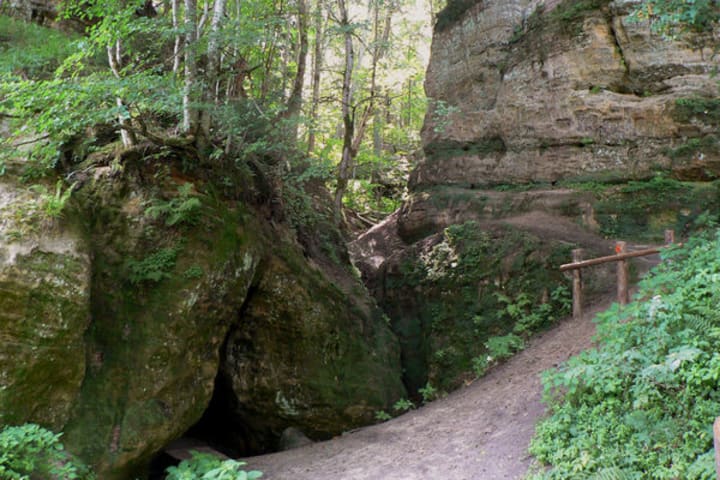
It was in the 1920s and 1930s that cultural workers began building homes along the Gauja. In 1964 Latvian opera singer Anna Ludina set up an artist’s garden and dendarium at her home known as “Ligotne”. Today one can see 150 different trees in the garden among which are around 70 exotic trees. This park has become protected since 1977. Here you can also see the Vangazi Lutheran Church which was built between 1780 and 1789. The architect was Pauls Kundzins and at one time in the 1930s the pastor of the church was Ludis Berzins who later became a refugee from his homeland.
Vangazi Lutheran Church

Kekavas Parish
Kekava Parish is located along the dryer part of the Daugava and one can see many forested and swampy areas on both sides of the Riga-Bauska Road. The most important architectural building is the Kekava Lutheran Church. It is a truly impressive church indeed. Not far from the church is the Dole People’s Building.
Kekava Lutheran Church
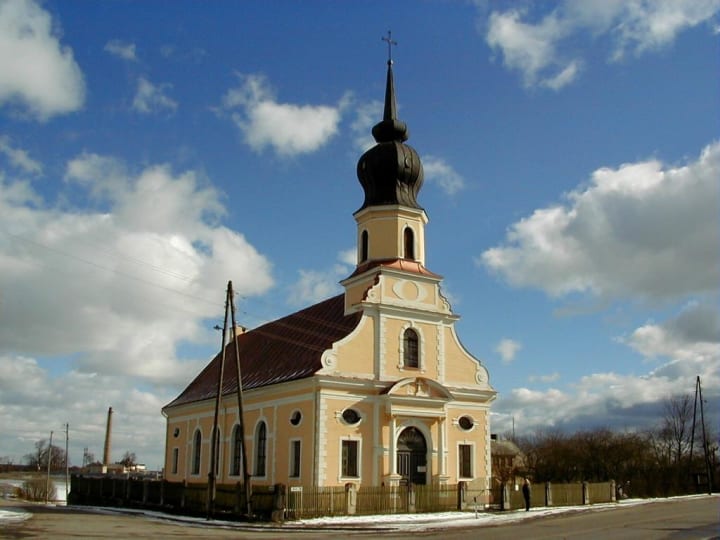
Also near the Riga boundary on the banks of the Daugava is the Katlakalna Church which has an adjacent cemetery. This church was built in the Burgher Classicism style and was built between 1791 and 1794. In the local cemetery is buried the great German writer and publicist Garlieb Merkel who was part of the Enlightenment of Latvia and was a dedicated defender of the rights of ethnic Latvians.
Not far from Katlakalns is the small Olekte River where there are some mini-estates. Among them the Depkina or Ramavas Estate in which Garlieb Merkels lived from 1808 to 1850. Here you will also find the oldest castle hill known as Klangu Hill and it dates back to the first millennium B.C. and is 20 meters high. On the bank of the Kekava River is a monument to Latvian riflemen from WWI which was put up by architect Eizens Laube in 1925.
Katlakalna Church
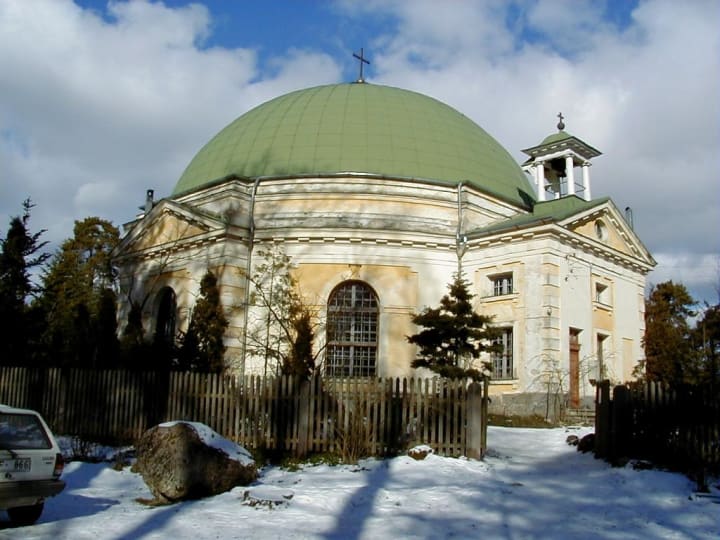
Malpils Parish
Malpils Parish lies along the Riga-Nitaure Road and dates back to 1207. The most important building is the Malpils Baronial Estate and is now a nationally protected landscape park. There is the lovely Malpils Lutheran Church which was built in 1766. Here is also the home of the Skulme Family of physicians and artists. An impressive building is the Buki Estate which includes a hunting cottage and other buildings from the 19th century.
Malpils Lutheran Church

Buki Estate

Marupes Parish
Marupes Parish is the gateway to Riga. The gardens of this parish provide Riga with fruit and vegetables. It lies along the Riga-Jelgava Railroad. It is a very important parish as in the northern part we find the Riga International Airport.
Riga International Airport

Marupe Parish also has one of the first golf courses in Latvia – “Viesturi”.
Viesturi
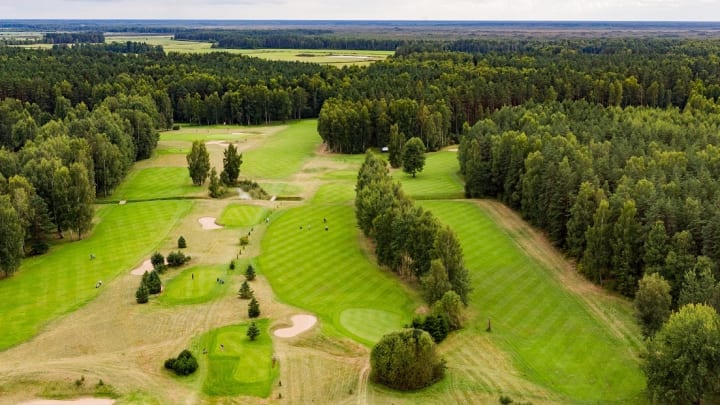
Town of Olaine
The town of Olaine was built between 1962 and 1963. The industrial area of the town stands separate from the residential area. It lies along the Riga-Jelgava railroad. The industrial zone is the site of a plastics company, a glue, and gelatin factory, and a chemical factory. The well-known pharmaceutical company Olainfarm is here also. Olaine has typical brick and panel residential high rises and institutions.
Olaine

Olaine Parish
Olaine Parish is located on both sides of the Riga-Jelgava Highway and railroad. The Olaine Lutheran Church is a prominent building which was built between 1749 and 1753. Architect Augusts Raisters drew up the plans for the church.
Olaine Lutheran Church

In the southern part is the neo-Gothic brick Peternieki Catholic Church. In the southeastern part are forests and agricultural land.
Peternieki Catholic Church

Ropazu Parish
Ropazu Parish is located in the eastern part of Riga District. The most populated areas are Ropazi and Zakumuiza (Rabbit Estate) on the banks of the Liela Jugla River. Ropazi dates back 1205. Two rivers Kreivupe and Tumsupe flow through the forested northern part. Ropazi is an agricultural center. The buildings around Zakumuiza date back to the 19th century.
Zakumuiza

Salas Parish
In Salas Parish the most prominent building is the St. John’s Lutheran Church built in 1870 in the style of Eclecticism and neo-Romanticism. Lake Babite is a favorite place to hunt ducks.
St. John’s Lutheran Church

Town of Salaspils and its Rural Territory
Salaspils and its rural territory are located alongside the Riga-Daugavpils Road and include the reservoir of the Riga hydroelectric station. Archaeological monuments in the parish include the ruins of Medieval castles at Jaundole and Vecdole. There is an ancient religious site called Monk’s Hill. Salaspils has the National Botanical Gardens which are found by the Salaspils Railroad Station. There is the lovely Salaspils Catholic Church.
Salaspils Catholic Church

A natural monument can be found on Dole Island – The Dole Estate.
The Dole Estate

Town of Saulkrasti and its Rural Territory
The town of Saulkrasti and the rural territory are located in a forested stretch of seaside land from the Lilaste River and Lake Lilaste to the south and up to and including Zvejniekciems in the north. The town itself lies along the Incupe and Kisupe Rivers, the Bay of Riga and the Riga-Skulte Railroad line. The Peterupe River flows through Saulkrasti and makes up Latvia’s second longest beach. In 1823 Karl Reitern founded a swimming area called Neubad for the nobility of Vidzeme region. Nowadays there are lots of summer homes here some of them dating back to the early 20th century. Of prominent importance is the Peterupes (Saulkrastu) Lutheran Church and it dates back to 1641. The beach at Saulkrasti is especially beautiful.
Saulkrasti Lutheran Church

Saulkrasti Beach

Sejas Parish
Sejas Parish covers a lot of area to the north of the Gauja and borders on Saulkrasti and Limbazi District. A great deal of land consists of forests, swamps, and meadows. The Seja Estate was built on an ancient castle mount and was once owned by the father-in-law of the legendary Baron Munchausen. In the estate’s park, there are 28 kinds of foreign trees including the mighty Seja Oak with a circumference of 9.1 meters and is the fourth thickest oak in Latvia. In the north part of the parish near the Peterupe River is the village of Pavazi. There is the so-called Vilku or Wolf gully has a small waterfall and island.
Mighty Seja Oak

About the Creator
Rasma Raisters
My passions are writing and creating poetry. I write for several sites online and have four themed blogs on Wordpress. Please follow me on Twitter.
Enjoyed the story? Support the Creator.
Subscribe for free to receive all their stories in your feed. You could also pledge your support or give them a one-off tip, letting them know you appreciate their work.






Comments
There are no comments for this story
Be the first to respond and start the conversation.